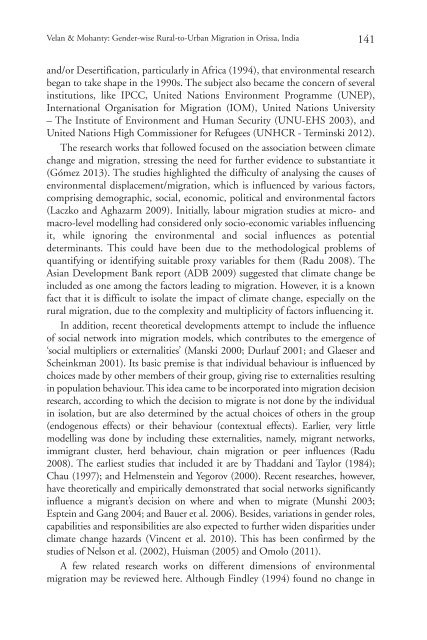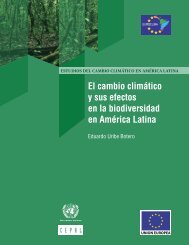Inequality and Climate Change Inégalité et changement climatique
Inequality
Inequality
You also want an ePaper? Increase the reach of your titles
YUMPU automatically turns print PDFs into web optimized ePapers that Google loves.
Velan & Mohanty: Gender-wise Rural-to-Urban Migration in Orissa, India 141<br />
<strong>and</strong>/or Desertification, particularly in Africa (1994), that environmental research<br />
began to take shape in the 1990s. The subject also became the concern of several<br />
institutions, like IPCC, United Nations Environment Programme (UNEP),<br />
International Organisation for Migration (IOM), United Nations University<br />
– The Institute of Environment <strong>and</strong> Human Security (UNU-EHS 2003), <strong>and</strong><br />
United Nations High Commissioner for Refugees (UNHCR - Terminski 2012).<br />
The research works that followed focused on the association b<strong>et</strong>ween climate<br />
change <strong>and</strong> migration, stressing the need for further evidence to substantiate it<br />
(Gómez 2013). The studies highlighted the difficulty of analysing the causes of<br />
environmental displacement/migration, which is influenced by various factors,<br />
comprising demographic, social, economic, political <strong>and</strong> environmental factors<br />
(Laczko <strong>and</strong> Aghazarm 2009). Initially, labour migration studies at micro- <strong>and</strong><br />
macro-level modelling had considered only socio-economic variables influencing<br />
it, while ignoring the environmental <strong>and</strong> social influences as potential<br />
d<strong>et</strong>erminants. This could have been due to the m<strong>et</strong>hodological problems of<br />
quantifying or identifying suitable proxy variables for them (Radu 2008). The<br />
Asian Development Bank report (ADB 2009) suggested that climate change be<br />
included as one among the factors leading to migration. However, it is a known<br />
fact that it is difficult to isolate the impact of climate change, especially on the<br />
rural migration, due to the complexity <strong>and</strong> multiplicity of factors influencing it.<br />
In addition, recent theor<strong>et</strong>ical developments attempt to include the influence<br />
of social n<strong>et</strong>work into migration models, which contributes to the emergence of<br />
‘social multipliers or externalities’ (Manski 2000; Durlauf 2001; <strong>and</strong> Glaeser <strong>and</strong><br />
Scheinkman 2001). Its basic premise is that individual behaviour is influenced by<br />
choices made by other members of their group, giving rise to externalities resulting<br />
in population behaviour. This idea came to be incorporated into migration decision<br />
research, according to which the decision to migrate is not done by the individual<br />
in isolation, but are also d<strong>et</strong>ermined by the actual choices of others in the group<br />
(endogenous effects) or their behaviour (contextual effects). Earlier, very little<br />
modelling was done by including these externalities, namely, migrant n<strong>et</strong>works,<br />
immigrant cluster, herd behaviour, chain migration or peer influences (Radu<br />
2008). The earliest studies that included it are by Thaddani <strong>and</strong> Taylor (1984);<br />
Chau (1997); <strong>and</strong> Helmenstein <strong>and</strong> Yegorov (2000). Recent researches, however,<br />
have theor<strong>et</strong>ically <strong>and</strong> empirically demonstrated that social n<strong>et</strong>works significantly<br />
influence a migrant’s decision on where <strong>and</strong> when to migrate (Munshi 2003;<br />
Esptein <strong>and</strong> Gang 2004; <strong>and</strong> Bauer <strong>et</strong> al. 2006). Besides, variations in gender roles,<br />
capabilities <strong>and</strong> responsibilities are also expected to further widen disparities under<br />
climate change hazards (Vincent <strong>et</strong> al. 2010). This has been confirmed by the<br />
studies of Nelson <strong>et</strong> al. (2002), Huisman (2005) <strong>and</strong> Omolo (2011).<br />
A few related research works on different dimensions of environmental<br />
migration may be reviewed here. Although Findley (1994) found no change in





